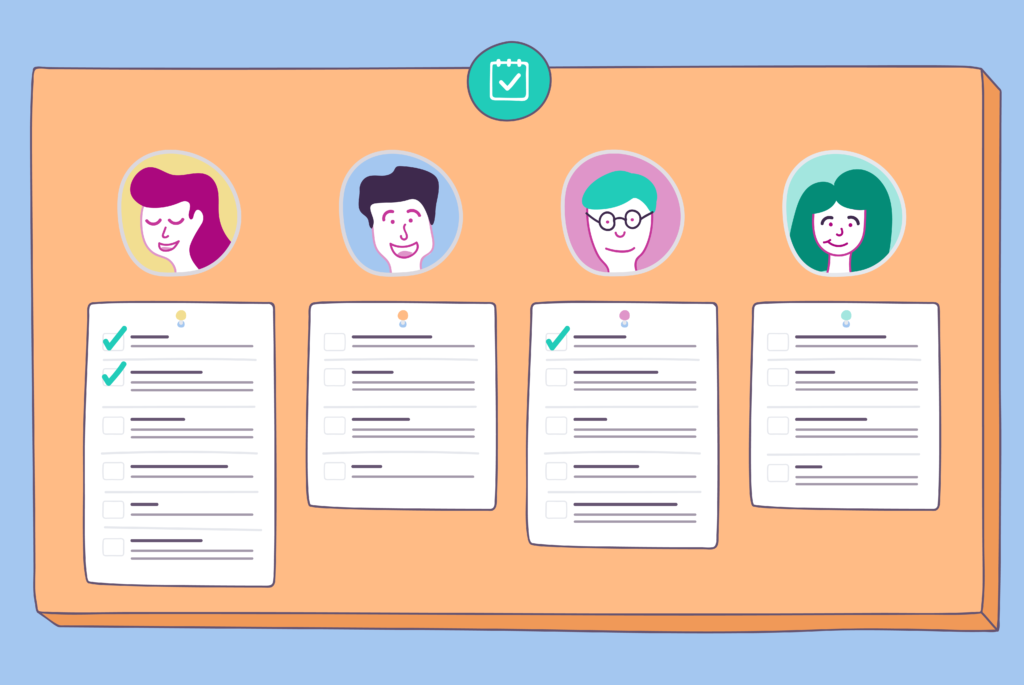As client demands increase and managers expect high levels of productivity from their employees, team members can quickly become overworked and experience burnout.
A Gallup study of nearly 7,500 full-time employees revealed that about two-thirds of workers experience burnout on the job.
Thirty-two percent of employees cited an unmanageable workload as a top contributor to burnout. When employees are overworked and stressed, they may find it challenging to complete all of their tasks. As their productivity declines, so does the team’s overall performance.
As a team leader, it’s your priority to distribute the work among team members evenly. Make sure you aren’t overworking some employees, while the other team members are doing less.
Here are six ways you can help your team manage their workload.
1. Don’t exhaust top performers

Most teams have a high-performing employee who volunteers to work overtime or take on the more challenging tasks. This person consistently delivers high-quality work in a short time, so it’s no surprise you tend to rely on them when a project comes up.
Although it can be easy to assign more responsibilities to employees who work faster and more efficiently, these workers can become overwhelmed and burned out. Not only is their productivity likely to decline, but high performers may resent having to carry the weight of the team.
Top workers are likely to have their plates full. Instead of piling extra work on them, check everyone’s schedule to see if someone else may be available to complete a project.
2. Understand why some team members are unproductive
While some team members have more than their fair share of work to do, others may not have enough. When there’s a workload imbalance, you’ll need to find out why individual team members are underperforming and redistribute the work evenly. For instance, they might find it challenging to complete specific projects or are dedicating too much time to the wrong tasks.
Approaching a team member about their low performance is never easy. However, it’s necessary to talk to employees to find out why inefficiencies are happening and how you can help them prioritize the right tasks and improve their time management skills. This way, you can balance out your entire team’s workload.
If one of your team members is a bit slower than the others, here are tips on how to approach them on this topic.
3. Establish transparent workflows and approval processes
When you assign tasks, it’s crucial that you get everyone on the same page by setting clear workflows and approval processes. You don’t want someone to start a project and then get stuck because there isn’t anyone to take over responsibility. Unclear workflows lead to lost projects and unhappy clients.
Set a clear workflow, so everyone understands who does what and when. For instance, determine who will edit, who will approve, and who will send content to the client once the first draft is ready.
Be sure to delegate these tasks to different team members, so you don’t overwhelm any one person by having them edit, approve, and send content for all client accounts. Be sure to document the workflow so if anyone forgets a step, they can rely on a specific document to set them on the right course.
4. Assign tasks based on employee strengths

Workers who have the opportunity to do what they do best are 57% less likely to experience burnout regularly. You’ll get the best work out of your employees if you can recognize their strengths and assign them tasks that allow them to use their natural talents and maximize productivity.
Consider the capabilities of each employee when assigning tasks. For instance, if someone is better suited to interact with clients, assign them work that calls for that. Likewise, if a team member struggles with content ideas but has a knack for editing, then assign them more editing tasks.
It’s a good idea to check in with employees frequently so you can understand any new skills they may have learned and plan future tasks accordingly.
Also, check in with employees on areas where they want to improve. Maybe they are not strong writers but would like to develop that skill. You can give them non-timely writing tasks that help them learn best practices.
5. Prioritize tasks
Before you can successfully distribute your team’s workload, you should prioritize tasks first. Not every job is a priority, so it’s crucial to find the right balance to help team members juggle everyday tasks with more urgent projects that may come up.
Consider your list of tasks and organize them in order of importance. If you have a high priority project and someone who can complete it quickly, be sure to assign that task first.
Prioritizing tasks will help employees plan their workday accordingly and increase their efficiency.
6. Keep the lines of communication open

Employees with managers willing to listen to their work-related problems are 62% less likely to be burned out. It’s critical to establish a relationship with employees where they feel comfortable enough to come to you and discuss any ongoing projects. Overworked employees who find you unapproachable are less likely to be productive.
Not every team member will feel comfortable voicing their thoughts. However, you can create anonymous surveys to get feedback from your employees on workload distribution. You can find out if everyone on the team thinks the workload is fair, or get suggestions on how to solve an issue.
The last thing you want to do is overwork your employees with a heavy workload. You also don’t want to jeopardize client relationships due to lack of productivity. It’s vital that you create and maintain a well-balanced work environment to prevent employee burnout and increase overall productivity.
Mindfulness also plays a role in making sure team members don’t get too stressed at work. Read our blog on tips for incorporating mindfulness in the workplace.






